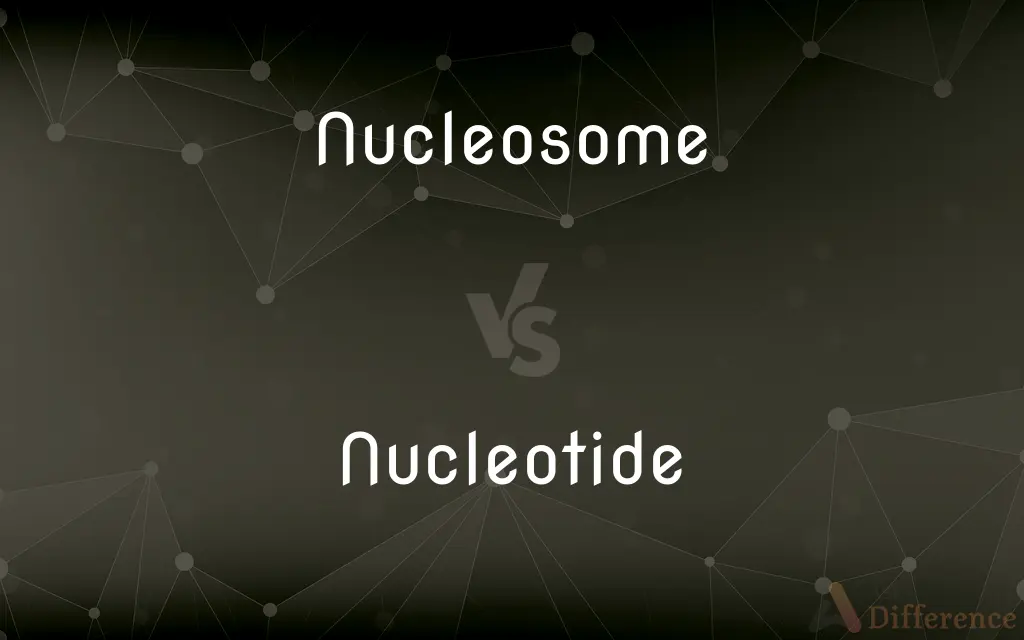Nucleosome vs. Nucleotide — What's the Difference?
By Fiza Rafique & Maham Liaqat — Updated on March 29, 2024
Nucleosomes are protein-DNA complexes forming chromatin structure, while nucleotides are DNA and RNA building blocks.

Difference Between Nucleosome and Nucleotide
Table of Contents
ADVERTISEMENT
Key Differences
Nucleosomes are structural units within the chromatin of eukaryotic cells, made up of DNA wrapped around histone proteins, facilitating DNA packaging into the nucleus. On the other hand, nucleotides consist of a phosphate group, a sugar molecule (deoxyribose in DNA and ribose in RNA), and a nitrogenous base (adenine, thymine, guanine, cytosine in DNA; adenine, uracil, guanine, cytosine in RNA).
Nucleosomes allow for the efficient packaging of DNA in the nucleus by coiling and folding into higher-order structures, which is essential given the extensive length of DNA molecules. Whereas nucleotides, through their sequential arrangement in DNA or RNA, determine the genetic information that directs cellular functions, including the synthesis of proteins.
The formation of nucleosomes involves the assembly of DNA around a histone octamer, comprising two copies each of histones H2A, H2B, H3, and H4. This structure is crucial for compacting DNA and regulating access to genetic information. Nucleotides, however, do not form complex structures by themselves but link together via phosphodiester bonds to form the long chains of DNA or RNA.
Nucleosomes are dynamically remodeled in response to cellular signals, allowing specific genes to be exposed or hidden from the transcription machinery as needed for gene expression or silencing. Nucleotides, in their role, undergo chemical modifications that can affect gene expression, such as methylation of cytosine bases in DNA, but do not involve changes in higher-order structure.
The study of nucleosomes has led to insights into epigenetic mechanisms, where modifications to histone proteins affect gene expression independently of the DNA sequence. Conversely, research on nucleotides has been central to understanding genetic diseases, mutations, and the molecular basis of life, highlighting their distinct but interconnected roles in biology.
ADVERTISEMENT
Comparison Chart
Composition
DNA wrapped around histone proteins
Phosphate group, sugar molecule, nitrogenous base
Function
Facilitates DNA packaging, regulates gene expression
Building blocks of nucleic acids, carries genetic information
Structure
Octamer of histone proteins with DNA coil
Single unit with three components
Role in Genetics
Epigenetic regulation and DNA compaction
Genetic coding, replication, and transcription
Research Importance
Understanding of chromatin architecture and gene regulation
Basis of genetic information and molecular biology
Compare with Definitions
Nucleosome
The basic packaging unit of DNA in the nucleus, allowing for efficient compaction.
Nucleosome positioning is crucial for gene accessibility.
Nucleotide
Plays a central role in genetics as part of the structure of DNA and RNA.
Mutations often involve changes in nucleotide sequences.
Nucleosome
A complex of DNA and histone proteins that forms the primary unit of chromatin structure in eukaryotic cells.
During DNA replication, nucleosomes must be disassembled and reassembled.
Nucleotide
Involved in metabolic processes as energy carriers and enzyme cofactors.
GTP is a nucleotide that participates in protein synthesis.
Nucleosome
Comprises an octamer of histone proteins around which DNA winds.
Histone modifications can affect nucleosome stability and function.
Nucleotide
Determines the genetic code through its sequence in nucleic acids.
The sequence of nucleotides in DNA dictates protein synthesis.
Nucleosome
Involved in the epigenetic regulation of genetic material.
Nucleosome positioning can influence the epigenetic landscape.
Nucleotide
The basic building block of DNA and RNA, consisting of a sugar, a phosphate group, and a nitrogenous base.
ATP, a nucleotide, is essential for cellular energy transfer.
Nucleosome
Plays a key role in regulating gene expression by controlling access to DNA.
Nucleosome remodeling is a method of activating or silencing genes.
Nucleotide
Can undergo modifications that affect genetic expression and stability.
Methylation of nucleotides can silence genes.
Nucleosome
A nucleosome is the basic structural unit of DNA packaging in eukaryotes. The structure of a nucleosome consists of a segment of DNA wound around eight histone proteins and resembles thread wrapped around a spool.
Nucleotide
Nucleotides are organic molecules consisting of a nucleoside and a phosphate. They serve as monomeric units of the nucleic acid polymers – deoxyribonucleic acid (DNA) and ribonucleic acid (RNA), both of which are essential biomolecules within all life-forms on Earth.
Nucleosome
A structural unit of a eukaryotic chromosome, consisting of a length of DNA coiled around a core of histones.
Nucleotide
A compound consisting of a nucleoside linked to a phosphate group. Nucleotides form the basic structural unit of nucleic acids such as DNA.
Nucleosome
Any of the repeating subunits of chromatin found in eukaryotes, consisting of a DNA chain coiled around a core of histones.
Nucleotide
Any of a group of compounds consisting of a nucleoside combined with a phosphate group and constituting the units that make up DNA and RNA molecules.
Nucleosome
(genetics) Any of the subunits that repeat in chromatin; a coil of DNA surrounding a core of eight histones.
Nucleotide
(biochemistry) The monomer constituting DNA or RNA biopolymer molecules. Each nucleotide consists of a nitrogenous heterocyclic base (or nucleobase), which can be either a double-ringed purine or a single-ringed pyrimidine; a five-carbon pentose sugar (deoxyribose in DNA or ribose in RNA); and a phosphate group.
Nucleotide
A phosphate ester of a nucleoside; one of the monomeric components of DNA or RNA.
Nucleotide
A phosphoric ester of a nucleoside; the basic structural unit of nucleic acids (DNA or RNA)
Common Curiosities
What role do nucleosomes play in gene expression?
Nucleosomes regulate gene expression by controlling the accessibility of DNA to the transcription machinery, influenced by their positioning and histone modifications.
What is a nucleosome?
A nucleosome is a structural unit within chromatin, composed of DNA wrapped around a core of histone proteins, facilitating DNA packaging and regulation.
Can nucleotides form structures like nucleosomes?
No, nucleotides link together to form DNA or RNA strands but do not form complex structures like nucleosomes by themselves.
What distinguishes a nucleotide in DNA from one in RNA?
In DNA, the sugar is deoxyribose, and thymine is one of the bases, whereas in RNA, the sugar is ribose, and uracil replaces thymine.
What is a nucleotide?
A nucleotide is a molecular building block of DNA and RNA, consisting of a phosphate group, a sugar molecule, and a nitrogenous base.
How do nucleosomes and nucleotides contribute to genetics?
Nucleosomes help in DNA packaging and gene regulation, while nucleotides carry genetic information essential for cellular functions and inheritance.
How are nucleotides linked together?
Nucleotides are linked via phosphodiester bonds between the phosphate group of one nucleotide and the sugar of another, forming the backbone of DNA and RNA molecules.
Are nucleotides involved in energy transfer?
Yes, certain nucleotides, such as ATP, play crucial roles in cellular energy transfer and metabolism.
What is the significance of histone modifications?
Histone modifications can influence nucleosome stability and DNA accessibility, thereby affecting gene expression and chromatin structure.
How do nucleosome positions affect genetic information?
Nucleosome positioning can influence gene expression by making certain DNA regions more or less accessible for transcription.
Do nucleosomes exist in prokaryotes?
No, nucleosomes are characteristic of eukaryotic cells; prokaryotes do not have nucleosomes organizing their DNA.
How do nucleotides participate in protein synthesis?
Nucleotides form the RNA molecules that translate genetic information from DNA into the amino acid sequence of proteins.
What is the role of nucleotides in cellular metabolism?
Beyond their genetic functions, nucleotides serve as energy carriers (e.g., ATP) and enzyme cofactors in various metabolic processes.
Can the sequence of nucleotides in DNA change?
Yes, mutations can alter the sequence of nucleotides in DNA, potentially affecting the organism's phenotype and genetic information.
Share Your Discovery

Previous Comparison
Autotroph vs. Producer
Next Comparison
Skyline vs. CityscapeAuthor Spotlight
Written by
Fiza RafiqueFiza Rafique is a skilled content writer at AskDifference.com, where she meticulously refines and enhances written pieces. Drawing from her vast editorial expertise, Fiza ensures clarity, accuracy, and precision in every article. Passionate about language, she continually seeks to elevate the quality of content for readers worldwide.
Co-written by
Maham Liaqat













































